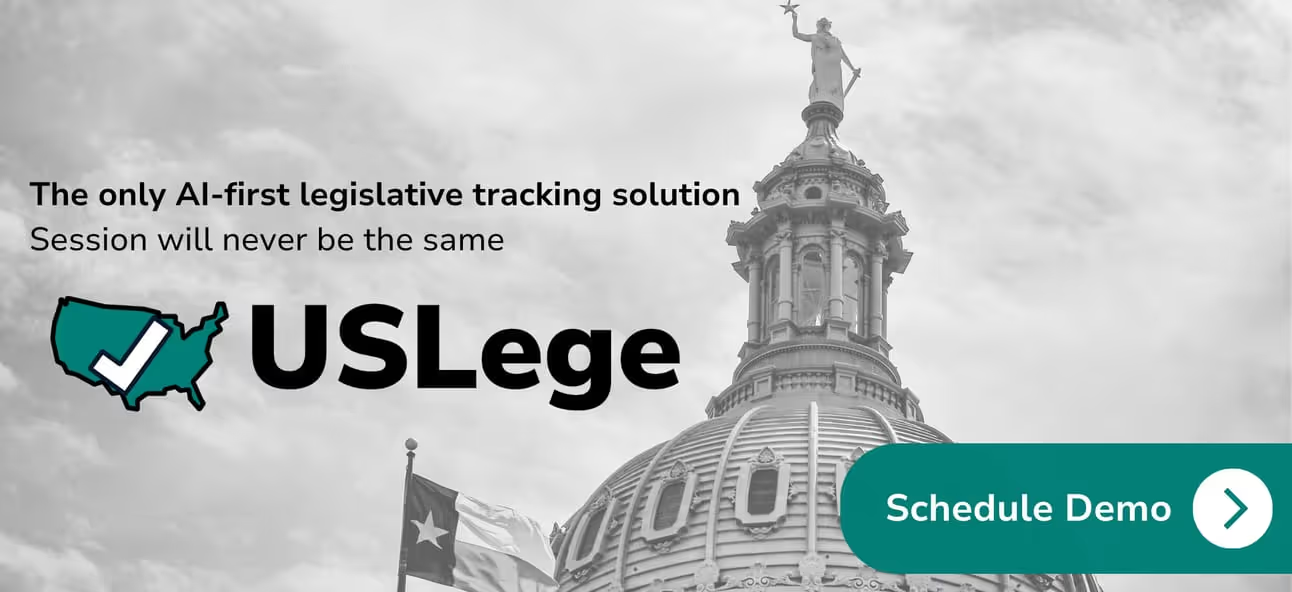
Welcome back, friends
Dustin Burrows has been elected as Speaker of the Texas House after a fierce contest, winning significant support from Democrats and drawing early and sharp criticism from Lt. Governor Dan Patrick. As he takes the helm, Burrows must now navigate the growing tensions within his party while balancing the conservative agenda with his commitment to bipartisanship.
Dustin Burrows of Lubbock has been elected Speaker of the Texas House of Representatives following a fiercely contested race that highlighted deep divisions within the Republican Party. His victory came after a protracted intra-party struggle, with Burrows securing bipartisan support, including votes from 49 Democrats. The election underscored a fundamental split among Texas Republicans, with Burrows' opponent, Rep. David Cook, representing the more conservative faction. Cook and his supporters supported and agenda which included blocking Democrats from holding key leadership positions, emphasized a more conservative vision for the House.
Burrows' election marks a continuation of the leadership style established by his predecessor, Dade Phelan. Burrows has pledged to maintain the tradition of collaboration and bipartisanship, stressing the importance of working with all members of the House. This approach, which has earned both praise and criticism, signals his commitment to navigating the ideological differences that currently define Texas politics. His leadership style contrasts with the more conservative faction within his party, which has grown increasingly dissatisfied with the legislative outcomes of recent years, particularly in relation to key issues such as abortion, immigration, and elections administration.
In a statement following Burrows’ election, Texas Lt. Governor Dan Patrick expressed strong concerns about the outcome. Patrick criticized the fact that Burrows’ election was secured with substantial Democratic support. Patrick pointed out that Burrows, despite receiving fewer Republican votes, was effectively handed the speakership by the minority party, which he argued was an anomaly in the history of Texas politics.
“One cannot imagine if the Democrats had 88 members of the Texas House that they would allow Republicans to elect the speaker. I am proud of the Republicans who stood together and voted for Rep. Cook, the House Republican Caucus nominee. Republican voters expected the new speaker to be elected by Republicans, not by Democrats.
- Lt. Governor Dan Patrick
Patrick’s statement made it clear that while he respected the outcome, he expected Burrows to deliver on key conservative legislative priorities that have stalled in the House in past sessions. These priorities include school choice, bail reform, taxpayer-funded lobbying restrictions, and measures to bolster election integrity. Patrick indicated his readiness to collaborate with Burrows and the Texas Senate, noting that conservative legislation passed by the Senate in previous sessions had failed to gain traction in the House. He called on the new speaker to ensure that these issues were brought to the forefront during the current session.
The tensions surrounding Burrows' election reflect broader political dynamics within Texas, with the state’s Republican leadership divided over the direction of the party. The more conservative faction, dissatisfied with the status quo, is pushing for more aggressive reforms on a range of issues, while the more moderate wing, represented by Burrows, seeks to maintain a more balanced approach. Burrows’ leadership will be tested in the months ahead as he navigates these competing pressures, with significant attention on how his bipartisan approach shapes the upcoming legislative session.
Burrows’ election likely ensues past idealogical battles over the state’s political future that will continue until at least the next primary election. The outcome of this speaker race has underscored the deep rifts within the party, and Burrows will need to demonstrate a keen ability to balance these forces to effectively lead the House in the coming years.
FULL VOTING BREAKDOWN
Green - Burrows
Red - Cook
White - Present Not Voting
We hope you enjoyed today’s read!
🎙️We Have a Podcast! 🎙️
Bills and Business is your go-to podcast for conversations related to Texas legislation and business. Hosted by Laura Carr, Co-Founder of USLege—an AI-driven legislative tracking software—we bring you in-depth analysis on economic trends, impactful legislation, and key developments shaping Texas business.
Subscribe on Youtube and Spotify for weekly episodes!

- 01 First
Subscribe to our Newsletter

Read more news
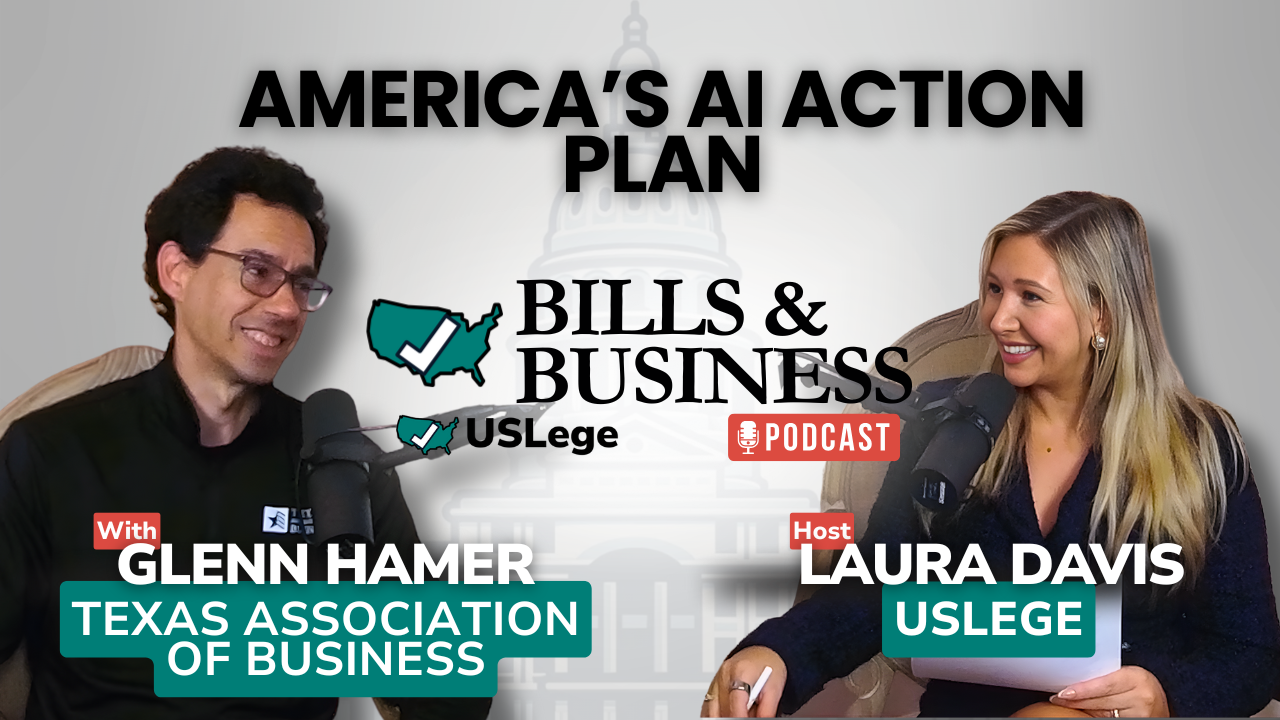
#42 - Glenn Hamer: America’s AI Action Plan
Welcome to Episode #42 of Bills & Business. In this episode, Laura Carr, Co-Founder of USLege, sits down with Glenn Hamer, President and CEO of the Texas Association of Business, to unpack the federal government’s new America’s AI Action Plan, a national strategy shaping the future of business, innovation, and competitiveness.
Glenn shares how this plan impacts Texas employers, entrepreneurs, and innovators, exploring its implications for AI infrastructure, workforce development, and global market positioning. Together, Laura and Glenn break down how policy decisions in Washington could fuel new opportunities in Texas’s energy, technology, and manufacturing sectors.
This conversation offers insight into the connection between federal AI policy and Texas’s business future, highlighting the state’s leadership potential in the next generation of innovation.
Don’t forget to subscribe to Bills & Business on Apple Podcasts, Spotify, and YouTube for more deep dives into Texas policy and business news.
📲 Follow Laura Carr
🐦 Twitter: @Laura_USLege
💼 LinkedIn: https://www.linkedin.com/in/laurauslege/
📸 Instagram: https://www.instagram.com/thereallauracarr/
🛍️ ShopMy: https://shopmy.us/shop/lauraluise?Section_title=latest-finds&tab=collections
✍️ Substack: https://lauraluise.substack.com/
🔗 Links: https://lauraluise.carrd.co/
📲 Follow USLege
✨ Instagram: https://www.instagram.com/uslege.ai/
📘 Facebook: https://www.facebook.com/USLegeai
🐦 Twitter: @USLege_ai
💼 LinkedIn: https://www.linkedin.com/company/uslege-ai/
🎧 Subscribe to Bills & Business
🌐 Website: https://www.uslege.ai/
▶️ YouTube: https://www.youtube.com/@BillsandBusiness
🎵 Spotify: https://open.spotify.com/show/22ZWg9VVb2AEGqyV14osNi?si=effe3795f8414171
🍎 Apple Podcasts: https://podcasts.apple.com/ph/podcast/bills-and-business-by-uslege/id1781059329
🎥 TikTok: https://www.tiktok.com/@uslege
📲 Follow Glenn Hamer
🐦 Twitter: @GlennHamer
💼 LinkedIn: https://www.linkedin.com/in/glennhamer/
🎬 Produced by USLege
📞 Want to see USLege in action? Schedule a demo today: https://www.uslege.ai/demo
#aipolicy #artificialintelligence #billsandbusiness #texasbusiness #uslege #txlege

How to Choose the Best Legislative Tracking Software for Your Organization
In today’s fast-paced policy environment, staying informed is a constant challenge. Bills, hearings, and regulatory updates move quickly across jurisdictions, creating risks for organizations that rely on timely information, including the risk of missing important information when relying on manual processes. Choosing the best legislative tracking software is one of the most effective ways to manage legislative and regulatory tracking efficiently, minimize missed opportunities, and strengthen decision-making.
This article walks you through how to evaluate legislative and regulatory tools, compare coverage and capabilities, and understand which features help government affairs professionals and public affairs teams stay informed and a step ahead of rapid change. You’ll learn how to assess software platforms, review vendor performance, and apply a clear framework to guide your organization’s choice.
If you’re exploring modern solutions for policy monitoring, visit the best legislative tracking software to see how advanced systems help professionals track activity and analyze critical information across multiple jurisdictions.
Why Legislative Tracking Software Matters
Every legislative session brings thousands of new bills and hearings across the federal government, state legislatures, and local governments. For government affairs teams and law firms that must monitor state legislation or track regulations, the pace of change can be overwhelming.
Without digital platforms, staff may spend hours each day manually searching databases, reading committee reports, and updating spreadsheets. That process isn’t just inefficient—it’s risky. Missing one act or amendment could affect compliance, advocacy strategy, or even public reputation. Relying on manual tracking increases the chance of overlooking important details in legislative information, which can lead to missing critical updates or changes.
The Challenge of Volume and Velocity
- Legislative and regulatory tracking spans bills, hearings, amendments, and regulations that appear daily.
- Strategic decisions depend on access to verified data and real-time alerts.
- Regulatory developments from government agencies can impact clients and advocacy groups instantly.
The Payoff
Automated tracking saves time, reduces human error, and delivers actionable insights faster. Teams can filter results, share updates, and focus their attention where it matters most—on influencing policy and shaping outcomes.
Key Features and Capabilities to Look For
Choosing the right tracking platform starts with understanding what differentiates effective tools from simple alert systems. Below are core features to evaluate before purchasing or implementing any solution.
Coverage Across Jurisdictions
The best systems provide a broad jurisdictional reach—from federal legislation to state legislative hearings and local government acts. Before committing, confirm whether the platform includes:
- Federal and state legislation: Bills, amendments, regulations, hearings, and newly introduced bills, with Congress as a key source for federal legislative tracking.
- Regulatory activity: Notices from agencies and committees.
- Comprehensive data sources: Congressional records, local archives, and state portals.
Understanding the dynamic nature of Capitol Hill is crucial, as legislative activity and staff turnover at the federal level can significantly impact advocacy strategies and tracking efforts.
If your team must monitor state legislation, check that the vendor’s coverage includes smaller states and municipalities that frequently pass niche regulations.
Real Time Alerts and Notifications
Fast updates are critical for professionals who manage compliance or advocacy campaigns. Strong systems offer:
- Instant email alerts for bill introductions, amendments, or new hearings.
- Custom filters for topics, sponsors, committees, or jurisdictions.
- Real-time dashboards showing where legislation is moving next.
- Collaboration tools so teams can assign follow-up actions or comments.
With real-time alerts, government affairs professionals and policy experts can respond before deadlines pass—ensuring that organizations stay ahead and fully informed.
Analytics, Reporting, and Insight Generation
Good tracking isn’t just about collecting raw data. It’s about turning that data into useful analysis. A well-built platform helps users:
- Create trend dashboards showing activity by topic, legislator, or region.
- Generate reports to brief clients, executives, or advocacy groups.
- Use artificial intelligence to compare bills, predict movement, or analyze outcomes.
- Access historical data for longitudinal analysis.
By combining analytics with visualization tools, organizations gain the context needed to make strategic decisions quickly.
Artificial Intelligence in Legislative Tracking
Artificial intelligence transforms how government affairs professionals and government relations teams approach legislative tracking. By harnessing AI, organizations can analyze massive volumes of legislative and regulatory data in real time, ensuring that no critical bill or regulation goes unnoticed. AI-powered tools can automatically identify and prioritize bills that align with an organization’s advocacy goals, generate personalized bill summaries, and even predict the likelihood of legislative movement—all with minimal manual intervention.
For government relations professionals, this means less time spent sifting through raw data and more time focusing on strategy, stakeholder engagement, and influencing policy outcomes. AI-driven platforms can scan every legislative chamber, flagging new bills and regulations that matter most to your organization. These actionable insights empower teams to stay ahead of policy developments, respond quickly to emerging issues, and confidently make strategic decisions. As artificial intelligence continues to evolve, it will play an increasingly vital role in helping professionals track legislation, analyze regulatory trends, and drive effective advocacy across all levels of government.
Ease of Use and Vendor Support
Complex systems often fail because users find them hard to operate. When evaluating tracking software, consider:
- Intuitive search functions and clear navigation.
- Vendor training, documentation, and help-desk responsiveness.
- Implementation timelines and onboarding resources.
- Integration options with CRM, compliance, or reporting platforms.
The easier the interface, the more likely professionals across departments—legal, advocacy, and communications—will actually use it.
Security and Data Protection
When it comes to legislative tracking, security and data protection are non-negotiable for government affairs professionals and organizations. The sensitive nature of legislative and regulatory data—combined with the need for accurate, up-to-date information—means that robust security measures are essential. Leading legislative tracking platforms employ advanced encryption, secure servers, and strict access controls to ensure that only authorized users can access critical information.
In addition, reputable platforms adhere to industry best practices and compliance standards, safeguarding client data from unauthorized access or breaches. This commitment to security allows government relations professionals to focus on their core strategy and advocacy efforts, knowing that their data is protected at every step. By selecting a platform with proven security protocols, organizations can confidently manage their legislative tracking activities and maintain the trust of stakeholders, clients, and team members.
Integration with Other Tools
For government affairs professionals, efficiency and collaboration are key to successful advocacy. That’s why seamless integration between legislative tracking platforms and other essential tools—such as CRM systems, email clients, and social media monitoring software—is so valuable. Integrated platforms enable government relations professionals to track bills, monitor legislator interactions, and analyze advocacy campaigns all in one place, reducing manual data entry and streamlining workflows.
By connecting legislative tracking with CRM systems, organizations can maintain a comprehensive record of stakeholder engagement, track the progress of key bills, and measure the impact of their advocacy efforts. Integration with communication tools also ensures that teams can quickly share updates, assign tasks, and coordinate responses to legislative developments. Ultimately, these integrations help government affairs teams stay ahead of policy changes, maximize efficiency, and deliver more effective results for their organizations and clients.
Cost, Scalability, and ROI
Pricing varies widely across platforms. Some charge by user, others by jurisdiction. Evaluate:
- Scalability: Can you expand access as new teams join?
- Hidden costs: Extra fees for integrations or data exports.
- ROI: Measure efficiency gains, reduced research hours, and improved regulatory compliance.
The right investment pays for itself through faster tracking, stronger insight, and better policy outcomes.
Building Your Decision-Making Checklist
A structured checklist helps teams evaluate multiple vendors objectively. Consider the following steps:
- Define scope: Identify which government levels—federal, state, local—your organization must monitor.
- Map stakeholders: Determine which departments, clients, professionals, or legislators need access to legislative tracking information.
- Create a scoring system: Rate vendors on coverage, alerts, analytics, ease of use, and cost.
- Request demos: Ask vendors to show how their tools track legislation and deliver reports.
- Review accuracy: Compare automated alerts to official legislative portals to confirm reliability.
- Pilot the system: Run a short test during a legislative session to evaluate performance.
This structured review allows government relations professionals and policy experts to make choices based on measurable evidence, not sales claims.
Common Pitfalls and How to Avoid Them
Even sophisticated organizations can stumble during implementation. Watch for these frequent errors:
- Assuming full coverage: Some systems exclude local governments or agency regulations. This can result in missing important government actions, leaving you unaware of key legislative or regulatory developments.
- Overloading users: Too many irrelevant alerts lead to fatigue.
- Ignoring integration: Platforms that don’t connect to existing tools reduce efficiency.
- Underestimating training: Teams may resist new systems without clear onboarding.
- Skipping metrics: Without KPIs, you can’t analyze ROI or improvement.
Avoiding these issues keeps your strategy grounded in real performance data.
Implementation Best Practices and Maximizing Value
Rolling out a new tracking platform works best when everyone understands the process. Follow these steps:
- Stakeholder alignment: Engage government affairs, legal, and communications teams early.
- Define taxonomy: Standardize issue tags, committees, and jurisdiction names.
- Workflow mapping: Assign ownership for monitoring, escalation, and communication.
- Training: Offer live sessions and short guides to reinforce adoption.
- Continuous review: Revisit settings each quarter to refine alerts and search filters.
As policy cycles shift, ongoing optimization ensures that your system remains accurate, relevant, and responsive to regulatory developments.
For additional insight on how legislative and regulatory tools operate, review the NCSL’s bill tracking overview, which explains how professionals track state legislation effectively.
Future of Legislative Tracking
The future of legislative tracking is bright, with rapid advancements in artificial intelligence, machine learning, and data analytics reshaping how government affairs professionals and organizations monitor and influence policy. As the demand for real-time, data-driven insights grows, legislative tracking tools will become even more sophisticated—offering predictive analytics, automated reporting, and deeper integration with other advocacy platforms.
We can expect to see greater adoption of cloud-based solutions, enhanced security features, and more intuitive user interfaces that make it easier for government relations professionals to access and analyze critical information. The integration of legislative tracking with CRM, communication, and analytics tools will provide a unified view of advocacy efforts, enabling teams to coordinate strategy and engage stakeholders more effectively.
As the policy landscape evolves, staying ahead of legislative and regulatory developments will be essential for organizations seeking to influence legislation and achieve their advocacy goals. By embracing the latest technologies and innovations, government affairs professionals can ensure they remain agile, informed, and ready to drive meaningful impact in an ever-changing environment.
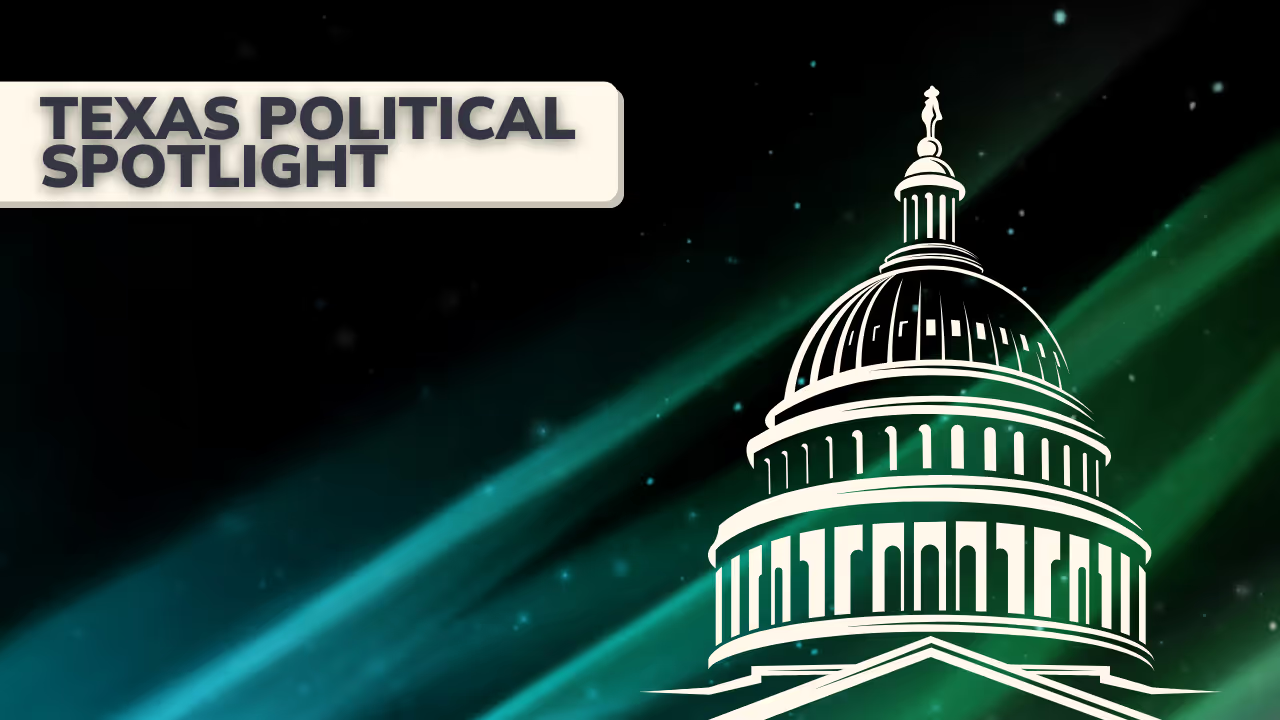
Texas Political Spotlight
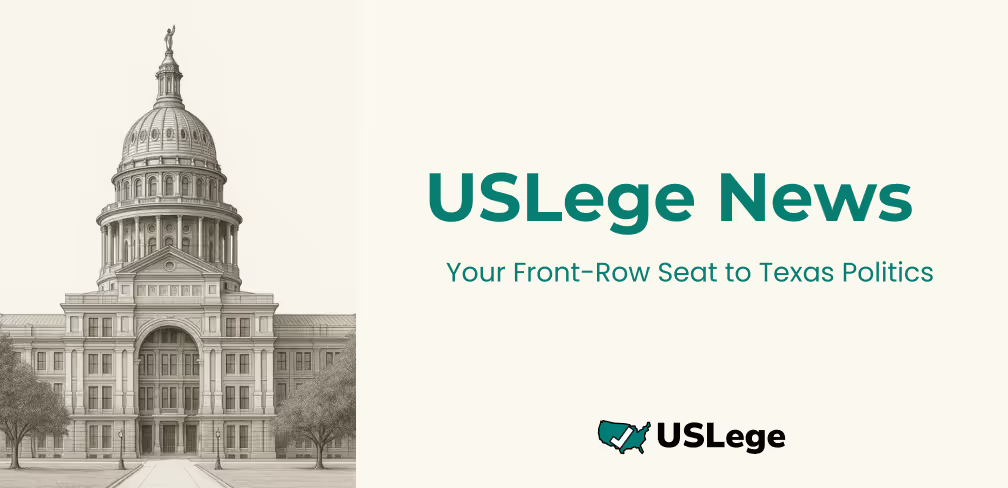
Welcome back, friends
Texas voters approved one of the largest property tax relief packages in state history on Tuesday, raising the homestead exemption to $140,000 and granting new tax breaks for seniors, people with disabilities, and small businesses. In Austin, residents rejected Proposition Q, a plan to fund public safety, homelessness programs, and city facility initiatives through a property tax hike, forcing city leaders to rework the budget and brace for service cuts. Meanwhile, Bexar County voters narrowly passed Propositions A and B, greenlighting up to $311 million in tourism-funded support for a new downtown Spurs arena and upgrades to the Freeman Coliseum grounds.
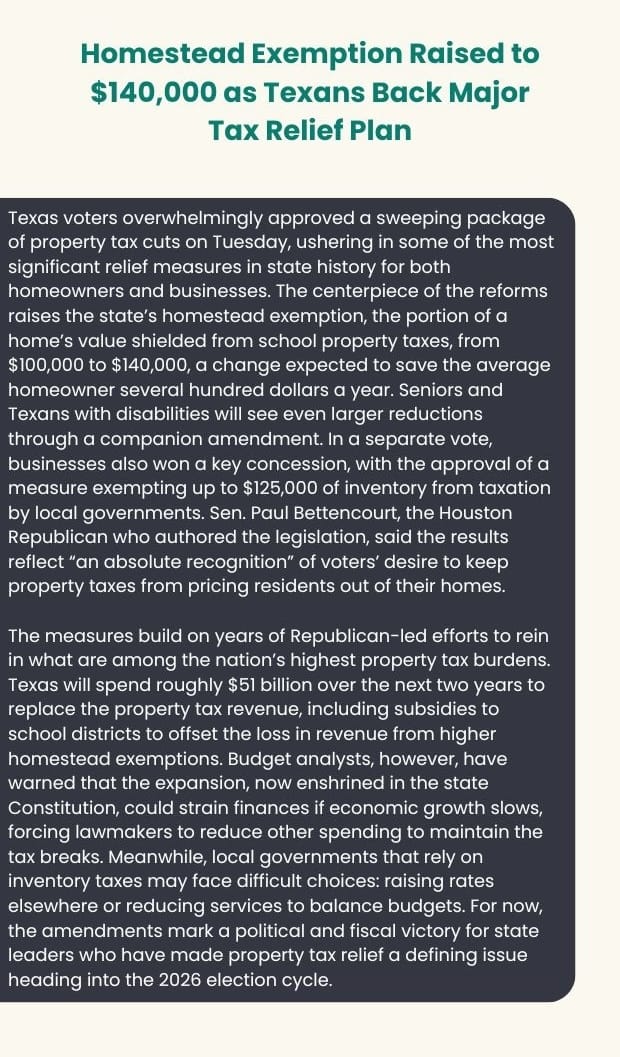
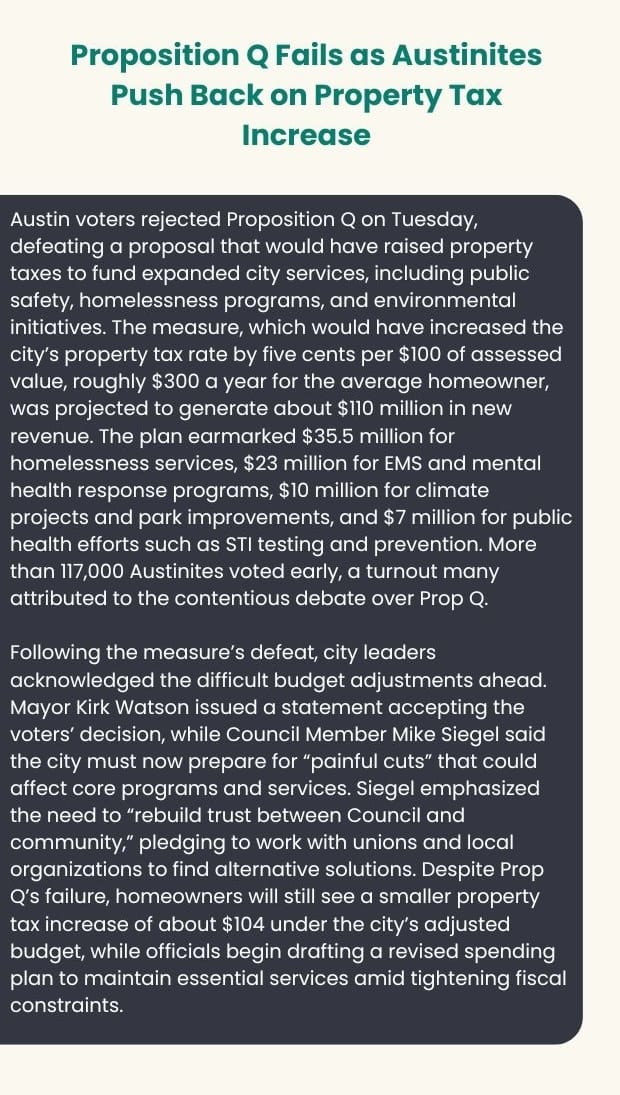

We hope you enjoyed today’s read!


